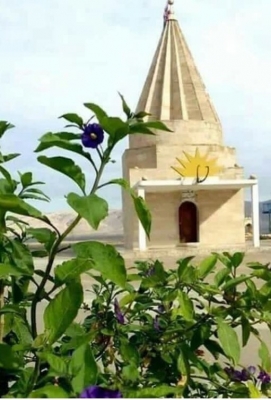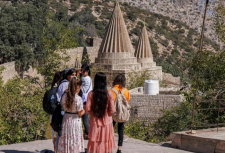Milete min Ezid
The Uniqueness of the Yazidi Concept of the Nation

Artur Rodziewicz
Jagiellonian University, Kraków, Poland
The Quraysh Tradition
By using the term “millet” the Yazidis qualify themselves as a separate independent group that differs from others. To name their community they use the previously mentioned word “Êzîd” (as well as “Êzîdxane”) and “Sunet” or “Sunetxane” (for more examples see: Rodziewicz 2018 a). Especially important is “Sunet”, the word of Arabic origin (from Sunna) which has a long theological tradition. One can find it both in the old poetical Yazidi works as well as in their modern everyday language. It must be strongly emphasized, however, that they use it mainly in the internal discourse (declaring themselves as “Sunet” in the presence of Muslim Sunni neighbours, could give rise to numerous problems). Sunet means “tradition” (Guraya 1972), and when the Yazidis call themselves “Tradition” or “The House of Tradition” (Sunetxane), they seem to imply that they are the representatives of the true religious tradition, the fundamental norm and practice, which goes back to pre-Islamic times. They see themselves as the descendants of those who did not follow Muhammad’s revolution, but who were faithful to the original tradition/ religion of Mecca. From the Yezdi perspective, Mecca is not only the holiest place of Islam but primarily the centre of an ancient religious cult. Therefore, it is no coincidence that the Yazidi holy valley in Iraqi Kurdistan, Lalish, is a topographical copy of Mecca, where they have their own Mount Arafat, Zem Zem spring, and Pira Silat bridge. Thus one can say that Lalish, together with local shrines, and first of all the Sheikh Adi’s sanctuary, is supposed to imitate Mecca from the Quraysh times.
Nor is it a coincidence that when the Yezidis point to the Sheikh Adi’s genealogy, they stress that he belongs to the Quraysh branch, as the descendant of the Umayyad caliph Marwan II (Aloian 2008). At the time when Adi came to Lalish from Baghdad, the local Kurdish tribes still remembered the Umayyads well and even surrounded them with a special cult (Lescot 1975, p. 21; Ahmed 1975, pp. 24-25, 243). Thus, it does not seem strange to connect the term “Yazid” (and the Yezidis) with the famous Umayyad caliph, Yezid ibn Mu’awiya, who was associated with the denial of the principles of Islam and his love for wine, poetry and mysticism. Numerous examples of the perception of a Yazid as such a person are present in the Yazidi oral tradition (in hymns and stories, Rodziewicz 2018a, pp. 294-300). However, the Yazidis are reluctant to mention this to foreigners, fearing the repercussions of Muslims, Artur Rodziewicz especially the Shiites, who accuse Ibn Mu’awiya of the death of Hossein (Ali ibn Abi Talib’s son). That is the reason why in conversation with strangers they usually derive their ethnonym from the Avestan yazata (“worthy of veneration”), the Persian īzad (“divinity”/ “deity”) or the Kurdish expression “Ez dam” or “Ez da” pointing to God’s act of creation and explaining that they are not “Yezidis”, but “Ezdis”, because – as one can hear – they worship Angels and God as the Creator of the universe. Therefore, when the Yazidis declare among themselves: Milete min Êzîd – that they are the “people” or the “nation” of “Yezid” – they treat the Umayyad caliph, also called “Sultan Yazid” (Siltan Êzîd) as a symbol of defender of the true religion and tradition connected with old Mecca. This idea is even more visible if one looks at the name of non-Yazidis, whom they refer to as “şerî’et” in contrast with the “Sunet”. Şerî’et, meaning literally “Law” (from the Arabic Shari’a), denotes those who do not belong to the Yezidi/ Sunet community – i.e. heretics, who did not follow the oral tradition, but have their own scriptures and are literate. So, through the distinction between the People of Tradition and the People of Shari’a they recall an old dispute from the very beginnings of Islam that started among the Qurayshites (Hawting 2000, p. 22) from whom Muhammad’s clan (Banu Hashim) descended along with the Umayyads.
Tags: #yazidisinfo #yezidi
Milete min Ezid
The Uniqueness of the Yazidi Concept of the Nation

Artur Rodziewicz
Jagiellonian University, Kraków, Poland
The Quraysh Tradition
By using the term “millet” the Yazidis qualify themselves as a separate independent group that differs from others. To name their community they use the previously mentioned word “Êzîd” (as well as “Êzîdxane”) and “Sunet” or “Sunetxane” (for more examples see: Rodziewicz 2018 a). Especially important is “Sunet”, the word of Arabic origin (from Sunna) which has a long theological tradition. One can find it both in the old poetical Yazidi works as well as in their modern everyday language. It must be strongly emphasized, however, that they use it mainly in the internal discourse (declaring themselves as “Sunet” in the presence of Muslim Sunni neighbours, could give rise to numerous problems). Sunet means “tradition” (Guraya 1972), and when the Yazidis call themselves “Tradition” or “The House of Tradition” (Sunetxane), they seem to imply that they are the representatives of the true religious tradition, the fundamental norm and practice, which goes back to pre-Islamic times. They see themselves as the descendants of those who did not follow Muhammad’s revolution, but who were faithful to the original tradition/ religion of Mecca. From the Yezdi perspective, Mecca is not only the holiest place of Islam but primarily the centre of an ancient religious cult. Therefore, it is no coincidence that the Yazidi holy valley in Iraqi Kurdistan, Lalish, is a topographical copy of Mecca, where they have their own Mount Arafat, Zem Zem spring, and Pira Silat bridge. Thus one can say that Lalish, together with local shrines, and first of all the Sheikh Adi’s sanctuary, is supposed to imitate Mecca from the Quraysh times.
Nor is it a coincidence that when the Yezidis point to the Sheikh Adi’s genealogy, they stress that he belongs to the Quraysh branch, as the descendant of the Umayyad caliph Marwan II (Aloian 2008). At the time when Adi came to Lalish from Baghdad, the local Kurdish tribes still remembered the Umayyads well and even surrounded them with a special cult (Lescot 1975, p. 21; Ahmed 1975, pp. 24-25, 243). Thus, it does not seem strange to connect the term “Yazid” (and the Yezidis) with the famous Umayyad caliph, Yezid ibn Mu’awiya, who was associated with the denial of the principles of Islam and his love for wine, poetry and mysticism. Numerous examples of the perception of a Yazid as such a person are present in the Yazidi oral tradition (in hymns and stories, Rodziewicz 2018a, pp. 294-300). However, the Yazidis are reluctant to mention this to foreigners, fearing the repercussions of Muslims, Artur Rodziewicz especially the Shiites, who accuse Ibn Mu’awiya of the death of Hossein (Ali ibn Abi Talib’s son). That is the reason why in conversation with strangers they usually derive their ethnonym from the Avestan yazata (“worthy of veneration”), the Persian īzad (“divinity”/ “deity”) or the Kurdish expression “Ez dam” or “Ez da” pointing to God’s act of creation and explaining that they are not “Yezidis”, but “Ezdis”, because – as one can hear – they worship Angels and God as the Creator of the universe. Therefore, when the Yazidis declare among themselves: Milete min Êzîd – that they are the “people” or the “nation” of “Yezid” – they treat the Umayyad caliph, also called “Sultan Yazid” (Siltan Êzîd) as a symbol of defender of the true religion and tradition connected with old Mecca. This idea is even more visible if one looks at the name of non-Yazidis, whom they refer to as “şerî’et” in contrast with the “Sunet”. Şerî’et, meaning literally “Law” (from the Arabic Shari’a), denotes those who do not belong to the Yezidi/ Sunet community – i.e. heretics, who did not follow the oral tradition, but have their own scriptures and are literate. So, through the distinction between the People of Tradition and the People of Shari’a they recall an old dispute from the very beginnings of Islam that started among the Qurayshites (Hawting 2000, p. 22) from whom Muhammad’s clan (Banu Hashim) descended along with the Umayyads.
Tags: #yazidisinfo #yezidi


























